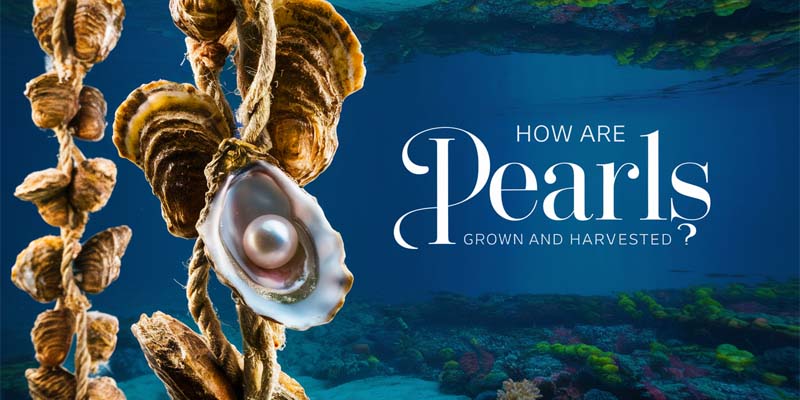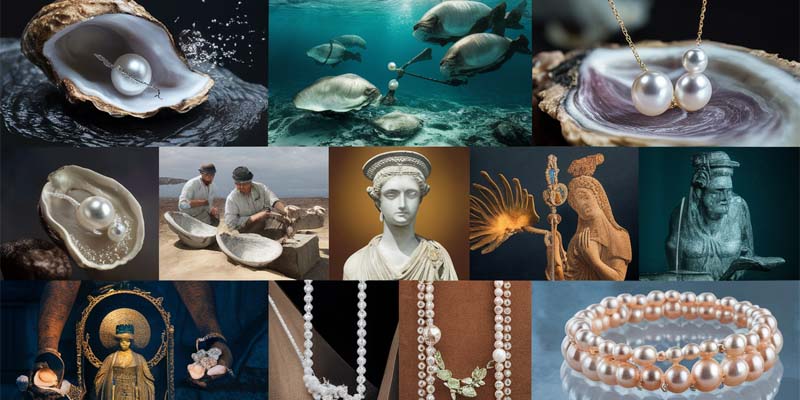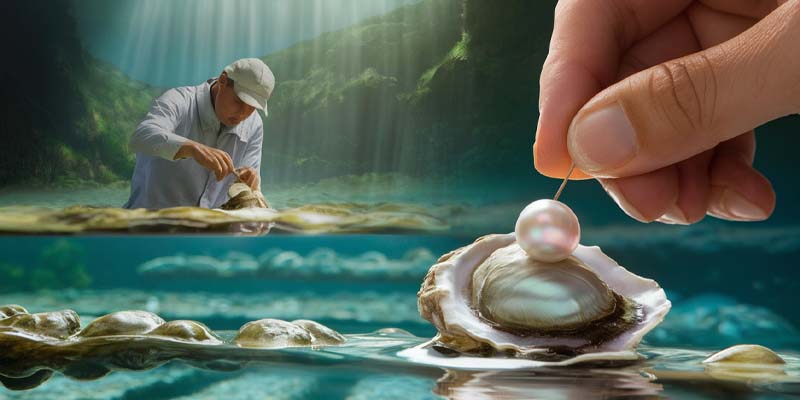
Unveiling the world of pearls
Pearls, with their soft radiance, have captivated human fascination for centuries, becoming symbols of purity, elegance, and wealth. But have you ever stopped to wonder how exactly a pearl comes into being? Pearls are essentially made of aragonite and conchiolin layers which are secreted by oysters and freshwater mussels as a defence against irritants to protect their body.

A brief overview of natural vs. cultured pearls
Pearls start their life in the depth of the oceans as a response to an irritant inside an oyster or mussel. Natural pearls are rare treasures, formed without any human intervention, making them highly prized and somewhat mythical. On the flip side, cultured pearls are born out of necessity and human ingenuity, where pearl farmers intricately work with nature to create these beautiful gems.
The significance of pearls in different cultures

Across various cultures, pearls have held significant importance – from being symbols of purity in ancient Greece to representations of wisdom in Eastern traditions. Their allure bridges cultures and timelines, making them timeless treasures.
Understanding the Basics of Pearl Formation
The role of an irritant in pearl creation
A tiny intruder, often a grain of sand or a parasite, finds its way into the oyster, causing the mollusk discomfort. To soothe this irritation, the oyster secretes layers of aragonite and conchiolin, eventually forming a pearl. It’s nature’s way of turning an annoyance into beauty.
Natural pearls - A rare phenomenon
Natural pearls are serendipitous gifts of nature. The chances of finding a pearl in a wild oyster are slim, making them rare and, often, exorbitantly priced.
Cultured pearls - Science meets nature
Cultured pearls, however, are a collaboration between humans and nature. By carefully introducing an irritant into an oyster, pearl farmers mimic the natural process, resulting in the creation of a pearl.
The Cultivation Process - How Pearls Are Grown
Cultured pearls are grown over six months or more. To grow bigger pearls, it can take up to four years. The process begins with the making of the pearl farm. The place should mimic the natural environment of oysters to ensure superior quality of the pearls. Let us explore in depth the stages of growing and harvesting pearls:
The Birth of a Pearl Farm
Selecting the right location
The location of a pearl farm is crucial. The ideal conditions to cultivate pearls include clean, temperate waters that mimic the oyster's natural environment, ensuring they can thrive and produce high-quality pearls.
The importance of water conditions
The water quality directly impacts the oysters’ health and the quality of the pearls they produce. Pearl farmers invest significant effort in monitoring and maintaining optimal water conditions.
Species of oysters and mussels used in pearl farming
Different species are chosen based on the type of pearls they produce. For instance, the Akoya oyster is renowned for its classic white pearls, while the Tahitian black-lipped oyster produces the coveted black pearls.
The Intricacies of Pearl Oyster Farming
Once the farming conditions are set up, then comes the most crucial parts of the cultivation process- nucleation and post-nucleation care and maintenance to produce the finest quality pearls:
Choosing and preparing oysters for nucleation
Not every oyster will do. Farmers select the healthiest oysters, prepping them gently for the nucleation process, ensuring they are at the peak of their pearl-producing abilities.
The nucleation process - A skilled craft
Nucleation is an art and science requiring precision and care. A skilled technician delicately introduces a tiny bead or piece of mantle tissue into the oyster, setting the stage for pearl formation.
Post-nucleation care and maintenance
After nucleation, the oysters require tender care. They are placed in baskets or nets and returned to the water, where they're regularly monitored and protected from predators and diseases.
Monitoring Growth and Health
Continuous monitoring is the key to rendering the oysters healthy enough to sustainably continue producing quality pearls.
The crucial role of environmental monitoring
Farmers continuously monitor water quality, temperature, and other environmental factors, as any shift can affect the oysters' health and the developing pearls.
Addressing health concerns in pearl oysters
Healthy oysters mean quality pearls. Farmers keep a vigilant eye for any signs of distress or disease in their mollusks, addressing issues quickly to safeguard their precious charges.
Time frame - From nucleation to harvest
The journey from nucleation to harvest can take anywhere from six months to several years, depending on the type and the size of the pearl being cultivated.
Harvesting Pearls - A Delicate Endeavor

Once the pearls are fully developed, it is time to harvest them. The process is extremely delicate and requires highly skilled professionals to ensure the oysters and mussels are not hurt in the process. It is also crucial to harvest them in order to get pearls with maximum luster.
The Moment of Truth - Harvesting Pearls
Timing the harvest
Harvesting is timed perfectly to when pearls have developed their full beauty but before they can be overgrown or lose their luster.
Techniques of opening oysters and mussels
Opening the oysters is done with the utmost care to not damage the pearl. It’s a moment filled with anticipation as each oyster holds the potential for a stunning gem.
The first glance: Assessing the pearls' quality
The reveal of a newly harvested pearl is always a breath-holding moment. The quality – including size, color, and luster – is assessed, determining the pearl’s destiny in the jewelry world.
From Harvest to Market
Pearls are among the few gems that do not need much processing before they are ready for the market and jewelry making. Cleaning and sorting is all there is to be done.
Cleaning and sorting pearls
Once harvested, pearls are gently cleaned and sorted. This meticulous process ensures that only the best pearls make it to the market.
The grading process
Pearls are graded on several criteria such as size, shape, color, luster, and surface quality. This grading process is vital, as it helps in determining the value and potential use of each pearl.
Preparing pearls for the market
Finally, pearls are drilled, matched, and sometimes set into jewelry, ready to adorn enthusiasts around the globe.
Challenges and Risks in Pearl Harvesting
Pearl harvesting is not a challenge. From keeping the oysters healthy and alive to harvesting without damaging the pearls- much effort goes into the process:
Environmental impact and sustainability concerns
Pearl farming, like any aquaculture, faces challenges related to environmental sustainability. Responsible farmers work tirelessly to minimize impacts, ensuring that pearl farming can continue for generations.
Mitigating the risks of overharvesting
Overharvesting is a concern for natural pearls. However, cultured pearl farming can alleviate this by providing an alternative that reduces pressure on wild oyster populations.
Ethical considerations in pearl farming
Ethical pearl farming ensures fair treatment and sustainable practices. It's about protecting both the environment and the people involved in the cultivation and harvest process.
Innovations and Future of Pearl Cultivation
Pearls are classic gems whose appeal has not faded over the years. Thus, it is natural that it will continue to be in high demand in the years to come.
Technological Advancements in Pearl Farming
Modern techniques and technologies, including automation and genetic research, are making pearl farming more efficient and sustainable.
Sustainable and Ethical Practices
Efforts are being made to advance sustainability and ethics in pearl farming, benefiting both the industry and the communities involved.
The Future Landscape of Pearl Farming
The pearl industry is evolving, with new markets emerging and a strong emphasis on conservation and sustainability. Cultured pearls play a critical role in this new landscape, offering a bridge between tradition and innovation.
Concluding Thoughts
The journey of a pearl, from a humble irritant to a treasured ornament, is a testament to the beauty and complexity of nature – and human ingenuity. As we adorn ourselves with these lustrous gems, let's appreciate not just their beauty but the intricate dance between the environment and skilled artisans that bring these treasures to light.
Pearls remind us that with care, patience, and respect for nature, we can turn challenges into opportunities for creating something truly beautiful. At Gesner, we strive to provide you with unique vintage designs with genuine precious stones that will create an impression for the wearer.
Website: https://gesner.com/
Check out our other pages:
Antique Engagement Ring: https://gesner.com/collections/antique-vintage-engagement-rings
Antique wedding bands: https://gesner.com/collections/antique-vintage-wedding-rings-bands